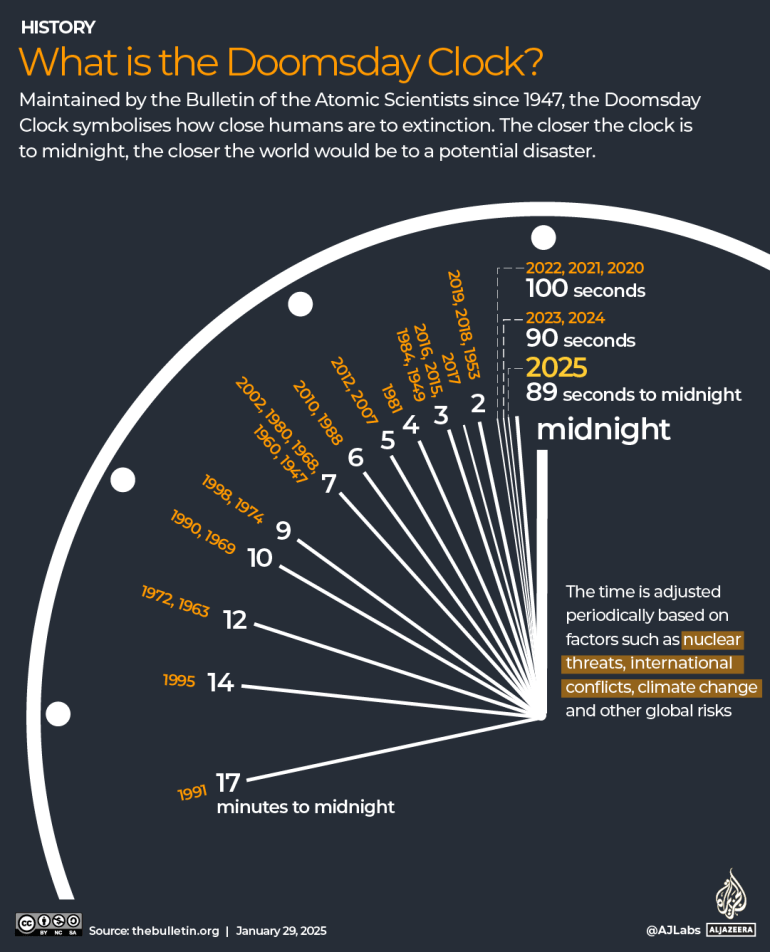The Bulletin of the Atomic Scientists (BAS) has moved the Doomsday Clock by one second to 89 seconds before midnight, indicating a greater risk of global catastrophe for the first time in three years.
The Bulletin of Atomic Scientists’ science and security board is satisfied that the world has not made sufficient progress in addressing the existential risks that threaten humanity as a whole. We thus move the clock forward”, Daniel Holz, chair of the organisation’s science and security board, said during a livestreamed event on Tuesday.
Ongoing threats from nuclear weapons, climate change, bioweapons, infectious disease, and disruptive technologies like artificial intelligence (AI) have brought the clock to its latest time in 78 years.
What is the Doomsday Clock?
According to BAS, a nonprofit organization with headquarters in Chicago, the Doomsday Clock is a symbolic timepiece that illustrates how close we are to “destroying our world with dangerous technologies of our own making.”
It describes , it as “many things all at once: It’s a metaphor, it’s a logo, it’s a brand, and it’s one of the most recognisable symbols in the past 100 years”.
The closer it moves to midnight, the closer humanity is to the end of the world.
Apocalyptic threats could arise from political tensions, weapons, technology, climate change or pandemics.
How is the clock set?
According to the scientists’ interpretations of existential threats at a specific time, the clock’s hands are moved closer to or farther away from midnight.
BAS updates the time annually. 10 Nobel laureates are among the members of a board that meets annually to discuss global events and decide where to put the clock’s feet on the ground.
“The Bulletin is a bit like a doctor making a diagnosis”, the BAS website says.
“We look at data, as physicians look at lab tests and x-rays, and also take harder-to-quantify factors into account, as physicians do when talking with patients and family members. We consider as many symptoms, measurements, and circumstances as we can. Then, it concludes, we have a conclusion that encapsulates what might occur if politicians and citizens don’t take action to improve the situation.
Has there ever been a turn-around?
The signing of the Strategic Arms Reduction Treaty (START) between US President George H. W. Bush and Soviet leader Mikhail Gorbachev in 1991 helped to reduce their respective nations’ nuclear weapons and ballistic missiles.
The clock was reset by seven seconds as a result. The clock has been running since midnight for 17 minutes.

When was the Doomsday Clock created?
The , clock was created in 1947 by the Bulletin of the Atomic Scientists, which was founded two years earlier by scientists Albert Einstein, J Robert Oppenheimer and Eugene Rabinowitch along with University of Chicago scholars.
During that time, the clock was set at seven minutes to midnight. But after the Soviet Union successfully tested its first atomic bomb in 1949, Rabinowitch, who was then the bulletin’s editor, moved the clock to three minutes to midnight.
According to the University of Chicago, until recently, the closest it had ever been set was at , two minutes to midnight:  , in 1953 when the US and the Soviet Union tested thermonuclear weapons and in 2018 because of “a breakdown in the international order, of nuclear actors, as well as the continuing lack of action on climate change”.
The University of Chicago’s BAS offices are home to the Doomsday Clock.
Source: Aljazeera

Leave a Reply